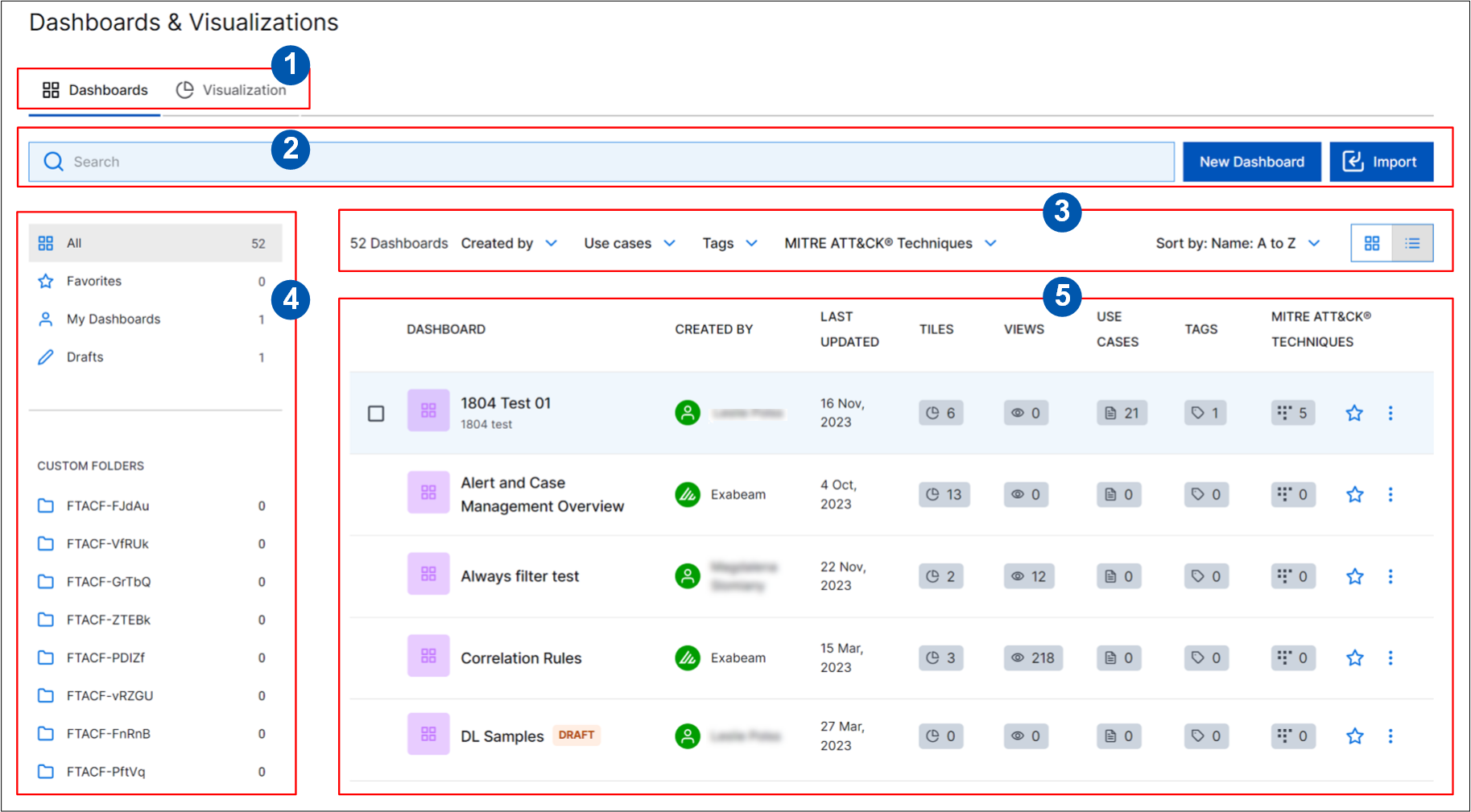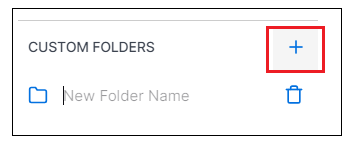- Dashboards
- Navigation Overview
- View and Interact with Dashboards
- View and Interact with Visualizations
- User Management
- Configure and Manage Dashboards
- Create a Dashboard
- Add a Visualization to a Dashboard
- Add a Text Tile
- Modify a Dashboard Layout
- Add Dashboard Filters
- Manage Automatic Refresh Rates
- Create a Scheduled Report
- Make a Dashboard Public
- Export and Import Dashboards
- Edit Dashboard Filters
- Edit Dashboard Details
- Duplicate a Dashboard
- Delete a Dashboard
- Configure and Manage Visualizations
- Create a Visualization
- Auto-Create a Visualization from a Natural Language Prompt
- Create a Visualization from a Search Query
- Add Visualizations from the Library to a Dashboard
- Modify a Visualization
- Configure Visualization Query Filters
- Include Context Filtering in Visualizations
- Make a Visualization Public
- Export and Import Visualizations
- Duplicate a Visualization
- Remove a Visualization from a Dashboard
- Delete Visualizations from the Library
- Configure and Manage Scheduled Reports
- Pre-Built Dashboards
- Advanced Analytics Dashboards
- AI/LLM Dashboards
- Case Manager Dashboards
- Compliance Dashboards
- Correlation Rules Dashboards
- Event Store Dashboards
- Access Grant and Revoke Activity
- Account Logout Summary
- Account Management Activity
- Application Security Event Summary
- Authenticated User Accounts on Hosts
- AWS CloudTrail Summary
- Data Loss Prevention Activity – Host-Based
- Data Loss Prevention Activity – User-Based
- Data Loss Prevention Activity Summary
- Default Account Access
- Default Credential Usage and Change Activity
- Denied Web Access Activity
- Disabled User Account Summary
- Discovered Attacks by Source and Destination
- Endpoint Detection and Response
- Failed Application Logon Activity
- Failed Audit Logs Summary
- Failed Host Login Attempt Counts by Users
- Failed VPN Login Attempts and Remote Session Timeouts
- Firewall Activity
- Firewall and Router Device Interfaces
- Insecure Authentication Attempts
- IOC Statistics
- Log Delay Insights
- Microsoft 365 Summary
- Microsoft Windows Overview
- Network Applications by Traffic Volume
- Policy Activity Summary
- Ports Usage Trend
- Privileged Access
- Privileged Access – User-Based
- Project Collateral
- Protocols by Network Traffic
- Remote Session Overview
- Security Alert Summary – Impacted Hosts
- Security Alert Summary – Origin Hosts
- Security Alert Summary – Users
- Successful Application Logon Activity
- Successful Database Login Activity
- Successful Physical Access
- Top Attackers
- User Account Creation Summary
- User Account Lockout Activity
- Vendor Authentication Activity
- Windows Audit Failure Summary by Hosts
- Windows Audit Failure Summary by Users
- Windows User Privilege Elevation
- Zscaler HTTP Dashboard
- Security Operations Center Management Dashboards
- Threat Center Dashboards
- Pre-Built Visualizations
- Anomalies - Use Case & MITRE Coverage
- Anomalies by Rule Name
- Anomalies by Use Case
- Anomalies Count Over Time
- Anomaly Distribution by MITRE Tactic & Score
- Application Count
- Closed Incidents
- Correlation Rules by Severity
- Correlation Rules Triggered Over Time
- Detected Anomalies
- Host-Based DLP Alerts Count
- Incidents Created
- Incident Summary by Incident Type
- Number of Hosts with DLP Alerts
- SOC Incident Distribution
- Top 5 Host-Based DLP Alert Categories
- Top 5 Protocols in Host-Based DLP Alerts
- Top 10 Host-Based DLP Alert Types
- Top 10 Hosts with DLP Alerts
- Top Activities per Top 10 Applications
- Top Users per Top 10 Applications
- Trend of Application Security Events
Navigate the Dashboards Tab
The Dashboards tab provides single-pane access to all your dashboards, both public and private. By default, when the Dashboards tab is displayed, it opens in the Favorites view and shows only those dashboards you have marked as favorites. If you have not yet marked any dashboards as favorites, the Dashboards tab opens in the All view and shows all of the existing dashboards.
The tab includes five main sections, as shown in the following image and described in the numbered points below.

Use the tabs at the top of the page to toggle the homepage display between dashboards, visualizations, and scheduled reports.
In the area under the tabs, you can:
Use the Search field to quickly locate specific dashboards. Search by dashboard name only.
Click New Dashboard to start creating a new dashboard from scratch. For more information, see Create a Dashboard.
Click Import to import external dashboards that were saved as a
.configfiles. For more information, see Import Dashboards.
The area beneath the Search field provides multiple ways to sort, filter, and view the currently displayed set of dashboards. From left to right, it provides the following options:
# Dashboards – Indicates how many dashboards are currently displayed. The number changes as you search or filter the dashboards.
Created by – Filter the display to show only dashboards created by one or more specific creators. You can also opt to display only Exabeam out-of-the-box dashboards or all custom dashboards.
Use cases – Filter the display to show only dashboards that have been assigned one or more specific use cases.
Tags – Filter the display to show only dashboards that have been assigned one or more specific metadata tags.
MITRE ATT&CK® Techniques – Filter the display to show only dashboards that have been assigned one or more specific MITRE ATT&CK® techniques.
Sort by: – Select a sort option for the displayed dashboards. Options include sorting by create or update dates, by creator name, and by dashboard name.
 List/Tile Selector – Toggle the display between the list view and the tile view. The list view is the default. All of the other filter and sort options apply to both the list and tile views.
List/Tile Selector – Toggle the display between the list view and the tile view. The list view is the default. All of the other filter and sort options apply to both the list and tile views.Cancel/Export/Delete – When you hover over a specific dashboard in the list or tile view and select the checkbox for that dashboard, an additional set of options are displayed to the left of the filter and sort options. These include options to Cancel, Export, or Delete the selected dashboard. You can select multiple dashboards to perform these actions in bulk.

In the left navigation panel, you can organize your dashboards into a folder structure. This folder structure provides an easy way to group, store, and access individual dashboards. The following types of folders are included:
All – Displays all of the existing dashboards, including dashboards in all of the other folders. This is the default display.
Favorites – Displays only the dashboards marked as favorites. To mark a dashboard as a favorite, click the favorite icon (
 ). It's on the far right of a dashboard row in the list view and on the top right of the dashboard tile in the tile view.
). It's on the far right of a dashboard row in the list view and on the top right of the dashboard tile in the tile view.My Dashboards – Displays only the dashboards you have created.
Drafts – Displays only the dashboards that you have created but have not published. These dashboards are marked with a Draft tag next to the dashboard name. They are visible only to the creator.
Custom Folders – Create and name your own folders where you can group dashboards according to your own hierarchy. When you hover over a custom folder, an options menu icon (
 ) is displayed. Click to display the menu where you can choose to Rename, Copy link, or Delete a specific custom folder. You can also take the following actions with custom folders:
) is displayed. Click to display the menu where you can choose to Rename, Copy link, or Delete a specific custom folder. You can also take the following actions with custom folders:To create a new custom folder, hover over the Custom Folder heading and click the add icon. Enter a name for the new folder.

Note
A total of 50 custom folders, across all users in your deployment, can be created for dashboards.
To assign a dashboard to a custom folder, click the options menu (
 ) for a specific dashboard and select Add to folder.
) for a specific dashboard and select Add to folder.To remove a dashboard from a custom folder, click the folder to display the dashboards it contains. Then click the options menu (
 ) for a specific dashboard and select Remove from this folder.
) for a specific dashboard and select Remove from this folder.
The list or tile panel on the right shows the set of dashboards currently displayed and provides powerful access to information about individual dashboards. Each dashboard is shown with its name, who created it, and the date it was last updated. You can interact with individual dashboards in the following ways:
Click a dashboard to open it for viewing or editing.
Hover over a dashboard to display a checkbox that can be used to select the dashboard for actions from the menu at the top, including Cancel, Export, and Delete. For more information about these procedures, see Configure and Manage Dashboards.
Click the favorite icon (
 ) for a specific dashboard to add it to the Favorites folder. Click the icon again to remove the dashboard from Favorites.
) for a specific dashboard to add it to the Favorites folder. Click the icon again to remove the dashboard from Favorites.Click the options menu (
 ) to select additional actions for a specific dashboard. Options include, Edit a dashboard, Copy link, Add to folder, Duplicate, Export, Delete. For more information about these procedures, see Configure and Manage Dashboards.
) to select additional actions for a specific dashboard. Options include, Edit a dashboard, Copy link, Add to folder, Duplicate, Export, Delete. For more information about these procedures, see Configure and Manage Dashboards.Hover over the different information icons on a specific dashboard to display detailed information:
 – Displays the number of tiles in the dashboard, including visualizations and text tiles.
– Displays the number of tiles in the dashboard, including visualizations and text tiles. – Displays the number of times a dashboard has been viewed.
– Displays the number of times a dashboard has been viewed. – Displays the use cases the dashboard is associated with.
– Displays the use cases the dashboard is associated with. – Displays the tags that have been assigned to the dashboard.
– Displays the tags that have been assigned to the dashboard. – Displays the MITRE ATT&CK® techniques the dashboard is associated with.
– Displays the MITRE ATT&CK® techniques the dashboard is associated with.